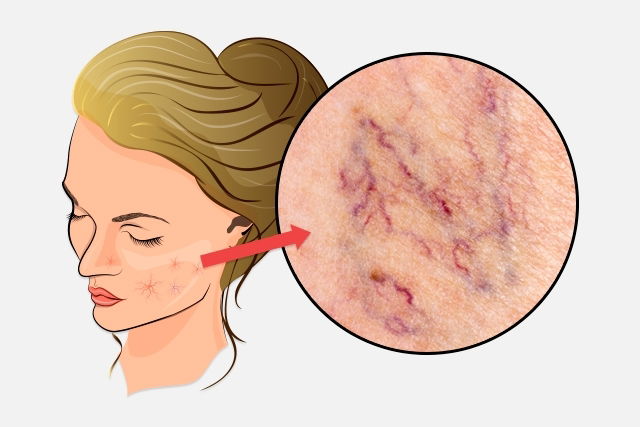Spider veins on the face is a common skin condition that most commonly affects visible areas of the face, like the nose, lips or cheeks. These small pronounced beins can lead to a mild pain or itching sensation.
Although it is not fully understood why spider veins appear, it is a benign problem caused by solar exposure. It is not associated with any health conditions, although in rare cases, they may be associated with rosacea or liver disease.
There are no known cures for spider veins, although some treatments, like laster therapy or sclerotherapy, can be formed by a dermatologist to improve the spider veins' appearance.

What causes spider veins?
The exact cause of spider veins on the face are not totally known, however there are many factors that appear to increase the chances for them to appear. These factors include:
- Excessive sun exposure
- Natural aging
- Family history
- Excess weight and obesity
- Excessive alcohol intake
- Use of birth control or corticosteroids
- Prolonged heat or cold exposure
- Injuries
Pregnant women, or people with acne or surgical incisions on the phase may also be more prone to developing spider veins.
In rare cases, spider veins can be a sign of a more serious health condition, like rosacea, Sturge-Weber disease, Rendu-Osler Weber syndrome, liver disease of hereditary hemorrhagic telangiestasia.
Confirming a diagnosis
Spider veins on the face are usually diagnosed by a dermatologist through a skin assessment. The doctor may opt to order additional testing, like blood work, a CT scan or an X-ray to rule out other possible causes.
Treatment options
Treatment for spider veins on the face are normally done by concealing them or improving the skin's appearance. Some of the most common techniques are:
- Make-up: This is aimed at concealing the spider veins. Its advantage is that it can be performed and utilized by most people on any skin tone.
- Laser therapy: This involves applying laser rays directly to the the spider veins to increase local temperature and close them. This will leave them less visible. This technique may require several treatments, and sessions should be performed by a trained professional. o;
- Sclerotherapy: A substance is injected into the veins, causing damage to the vein walls and weakeneing them. This technique is usually only performed on spider legs in the legs, however.
- Surgery: A small incision is made on the face to remove the spider veins for this technique. This treatment offers the best results, but may leave behind a small scar, and may lead to a more painful recovery period.
People with spider veins on the face should use sun screen before going outside, as sun exposure is associated with increased spider veins.
Spider veins that are secondary to other diseases may be treated by treating the underlying cause. Adhering to proper treatment can help to concel them and prevent new ones from forming.
